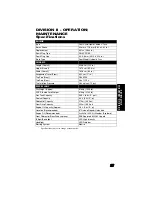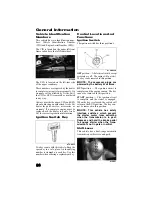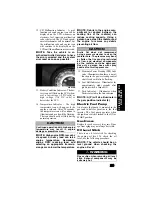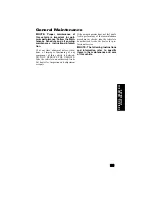
19
D
IVISION II - OPERA
T
ION/
MA
IN
TE
NANCE
Vehicle Operation
Starting the Vehicle
Always start with the vehicle on a flat,
level surface. Carbon monoxide poison-
ing can kill you, so keep the vehicle out-
side while it’s running. Follow these
steps to start it up:
1. Step into the vehicle and sit down;
then fasten the operator seat belt and
the passenger seat belts (if applicable)
and strap on your approved helmet
and require your passengers to do the
same (if applicable). Check that the
doors are secured and latched.
2. Shift into park.
3. Depress the brake pedal.
4. Turn the ignition switch clockwise to
the START position; then when the
engine starts, release to the RUN
position. Do not increase engine RPM
above idle.
5. Let the engine warm up.
Shifting the
Transmission
This vehicle is equipped with a constant
velocity transmission (CVT) coupled to a
dual-range transmission with reverse and
park. To shift the transmission, follow
these steps.
NOTE: The CVT is fully automatic
and shifts as a function of engine
RPM and vehicle loading.
1. To select high range from park, move
the shift lever forward through
reverse and neutral until the letter
“H” is displayed on the gauge.
WC093
2. To select low range from high range,
move the shift lever forward one
position until the letter “L” is dis-
played on the gauge.
WC094
NOTE: The high range is for nor-
mal driving with light loads. The low
range is for carrying heavy loads or
trailer towing. Compared to HIGH
range, the LOW range position pro-
vides slower speed and greater
torque to the wheels.
! WARNING
Falling from a moving vehicle could
result in serious injury or death.
Always fasten your seat belt securely
and ensure the passenger seat belt is
properly and securely fastened prior
to operating or riding in this vehicle.
CAUTION
Increasing engine RPM above idle
while in Park will cause belt damage.
CAUTION
Do not run the starter motor for more
than eight seconds per starting
attempt. The starter motor may over-
heat causing severe starter motor
damage. Allow 15 seconds between
starting attempts to allow the starter
motor to cool.
CAUTION
Always shift into low range when
operating on wet or uneven terrain,
when towing or pushing heavy loads,
and when using a plow. Failure to fol-
low this caution may result in prema-
ture V-belt failure or in damage to
related drive system components.
Содержание 2012 WildCat
Страница 57: ...55 Maintenance Record DATE MILEAGE SERVICE PERFORMED NOTES ...
Страница 58: ...56 NOTES ...
















































